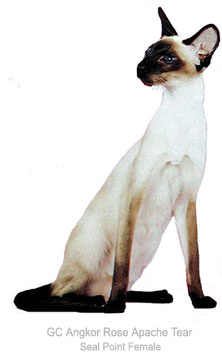





![]()
By Betty White
 Without question the Siamese has evolved in type from its earliest beginnings, but the evolution has been consistent with the vision of generations of its breeders all over the world whose cats echo the graceful elegance suggested in the earliest breed standards.
Without question the Siamese has evolved in type from its earliest beginnings, but the evolution has been consistent with the vision of generations of its breeders all over the world whose cats echo the graceful elegance suggested in the earliest breed standards.
Simply put, a Siamese is a living, breathing work of art that shuns a display shelf in favor of a lap! Long head, long body, long tail, long neck, long legs – everything about a Siamese is long with the exception of its short coat, a state of affairs which accentuates the body lines and underscores the porcelain-like quality of its visual image.
A tubular body, large ears, and fine bones contribute to this exquisite refinement of type. The long, wedge-shaped head graced by large ears that complete that triangle, straight profile, and lovely almond-shaped eyes contribute to a unique expression of feline beauty. When color contrast is excellent and correct, body color even and clear, and the eyes are a gorgeous deep blue, the resulting Siamese belongs in that "takes your breath away" category of all riveting great art.
Seal points, perhaps the best-known color, are lovely with their seal brown, almost black, points and pale fawn bodies. Chocolate points charm with their milk chocolate points and creamy white bodies. The blue point is captivating with its bluish white body and slate blue points. The lilac point has pinkish gray points with a while body which makes it most ethereal and delicate in color.
Imported into England in the late 19th century and appearing in catalogues of the Crystal Palace Show as early as 1881, the Siamese was first recognized in seal point. A description by Harrison Weir in Our Cats and All About Them (1889) of the ideal show specimen bears repeating:
The head should be long from ears to eyes, and not over broad, and then rather sharply taper off towards the muzzle, the forehead flat, and receding, the eyes somewhat aslant downwards towards the nose, and the eyes of a pearly, yet bright blue colour, the ears usual size and black with little or no hair on the inside, with black muzzle, and round the eyes black. The form should be slight, graceful and delicately made, body long, tail rather short and thin, and the legs somewhat short, slender, and the feet oval, not so round as the ordinary English cat. The body should be one bright, uniform, even colour, not clouded, either rich fawn, dun or ash. The legs, feet and tail black. The back slightly darker is allowable, if of a rich colour, and the colour softened, not clouded.
Clearly this is an exotic creature, in 1889 as well as today! What this description affirms is that mainstream Siamese breeders of today – most particularly those who breed, register, and show in CFA – are the direct descendants of the Siamese breeding tradition that began generations ago.
References:
- Weir H: Our Cats and All About Them. London, 1889.
- White, B: The Siamese. Cat Fancy. Feb. 1996. pp 32-33.
- White, B: We Are Siamese…Yesterday, Today & Tomorrow, Part 1. The Cat Fanciers’ Association Yearbook. Ocean, NJ, 1987. pp 658-665.
- White, B: We Are Siamese…Yesterday, Today & Tomorrow, Part 2. The Cat Fanciers’ Association Yearbook. Ocean, NJ, 1988. pp 178-185.

About NSCC :: Annual Show :: Membership Info
Join NSCC :: News :: Breeder Listings :: List Your Cattery
Rescue :: Links :: Contact Us
All Rights Reserved
Website Designed by
ShowCatsOnline Web Design
Maintained by Virginia Wheeldon


